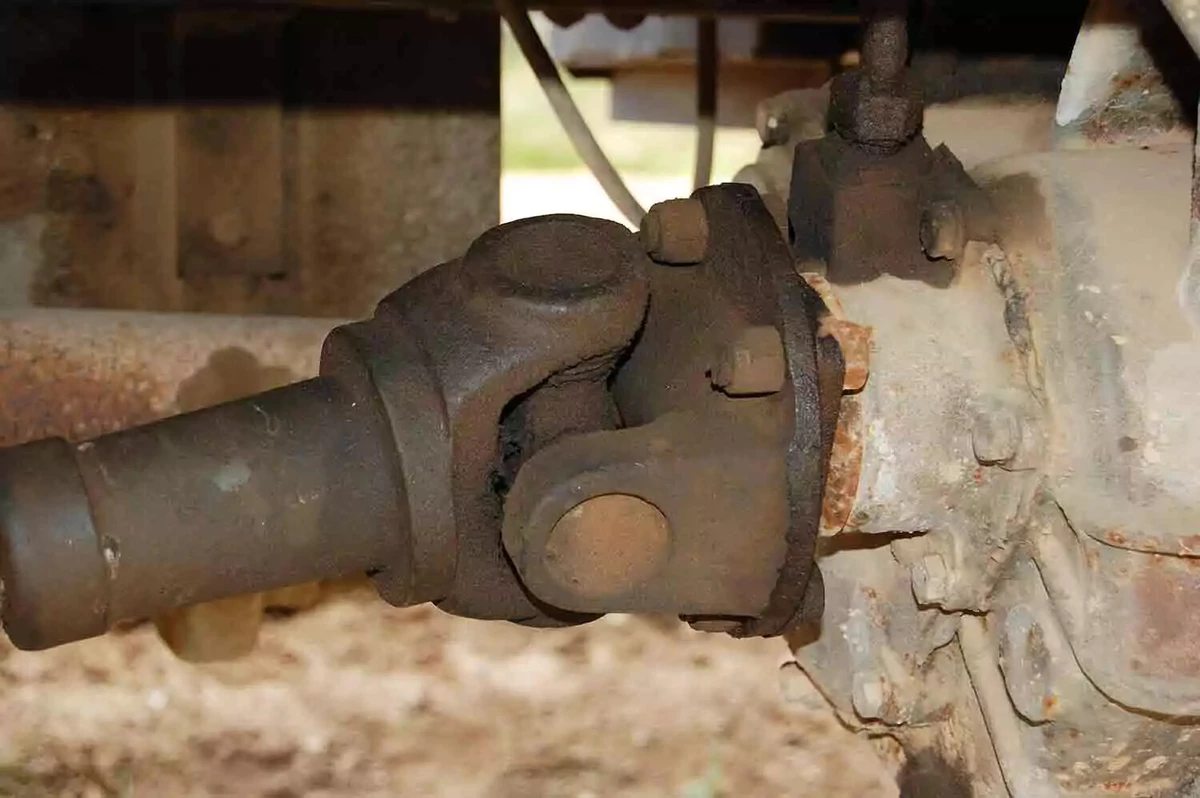
This U-joint provided many years of service.
Most cars (and many crossovers and SUVs) have front-wheel drive. The engine and transmission are up front and drive the front wheels. It’s space-efficient, easy to manufacture, and good for traction.
On the other hand, trucks, old-school SUVs, Jeeps, sports cars, and luxury cars mount the engine and transmission in the front and drive the wheels at the back. This means they use a driveshaft, a spinning shaft that takes power from the transmission or transfer case at the front to the differential or axle at the rear.
At each end of the driveshaft is a universal joint or U-joint. It allows the driveshaft to come down at an angle to meet the differential and moves up and down with the suspension. On top of that, it is a failsafe. A U-joint is meant to fail before the driveshaft. It’s easier and safer to replace just the U-joint rather than have the whole driveshaft break.
U-joints are shaped like a plus sign. At each end are needle bearings. This lets them move smoothly up and down and side to side. The ones in your vehicle work the same way as those in a universal joint extension on a ratchet or impact wrench.
Like all moving parts, U-joints wear out. Their needle bearings need grease, which goes bad or simply runs out. See our detailed step-by-step guide and video about replacing a U-joint - opens in new window or tab.. Also, check out our U-joint buying guide - opens in new window or tab..
Types of U-Joints

A MOOG non-treaseable U-joint
Front-wheel-drive cars do not have a driveshaft, so they use a constant velocity (CV) joint. U-joints are only found on rear-wheel-drive, four-wheel-drive, and all-wheel-drive vehicles.
Greaseable: All U-joints need grease. Greaseable U-joints have grease fittings and channels that run across the inside of the U-joint from that fitting to the bearings. You need to regularly re-grease this kind of U-joint to press out water or dirt that makes its way into the bearings.
Non-greaseable: These U-joints are sealed. The grease inside them lasts the lifetime of the part.
Non-greaseable U-joints are stronger than greaseable ones because non-greaseable U-joints don’t need internal channels. Owners of a vehicle with a lift kit that puts the driveshaft at an extreme angle often prefer the strength of non-greaseable U-joints. However, some off-roaders prefer greaseable U-joints because you can easily re-grease them after wading through deep water, dirt, or mud.
There are also two kinds of clips that hold U-joints in place:
Retaining clips: Most U-joints are held in place by small metal clips that can be removed or hammered out of place, either on the inside or (more likely) outside of the bearing.
Plastic injection: Some GM vehicles have pin holes at the yokes joining the driveshaft to the U-joints. These indicate a plastic injection U-joint. At the factory, melted plastic is injected into these holes to hold the U-joint in place. You have to melt out this plastic to free the U-joint.
How long do U-joints last?
Most manufacturers don’t have a service interval for U-joints. They commonly use sealed U-joints, which are meant to last the lifetime of the vehicle. In short, you only replace them when you notice that they are going bad. Typically, U-joints last between 100,000 and 150,000 miles.
Getting to that high mileage depends on what kind of U-joint you have. If you have U-joints with a grease fitting, they must be re-greased regularly. A good rule of thumb is to re-grease them every time you do an oil change. Or, after wading through water deeper than your axles, re-grease your U-joints.
Re-grease by hooking a grease gun to the grease fitting and refill the U-joint with grease until it pushes everything old out. When clean, new grease runs out of the U-joint, you’re done.
Even non-greaseable U-joints need maintenance. Inspect them for wear and replace them when they demonstrate more than a slight amount of play.
Signs of a Bad U-Joint
One of the most common signs of a bad U-joint is a clunking sound when shifting from drive to reverse. When the joint wears out, it develops too much play. That loosens the connection between the driveshaft and the transmission. When you shift or change your speed with a worn U-joint, the driveshaft moves suddenly, causing a loud clunk that’s easy to hear.
That same play in a bad U-joint can also make a rhythmic click or squeak as you start driving. This sound can go away at high speed.
On the highway, though, you may feel a vibration under your seat. This can be from a worn U-joint. This is especially noticeable at higher speeds.
The U-joint is responsible for enabling the suspension and steering to turn freely. If a U-joint goes bad, you might have difficulty turning. It could feel stiffer than you are used to. In some extreme cases where the joint completely fails, the connection between the transmission and driveshaft gets severed. The vehicle can stop moving entirely.
It’s easy to inspect your U-joint. Get under your vehicle and look at the U-joint. If the rubber boots around the ends are cracked, broken, or worn, water and debris are likely in the U-joint bearings. Then, grab and twist the driveshaft. If it twists more than a couple of degrees, it could be failing. Push the shaft (near each joint) back and forth on both axes. The joint should be firm and not slide at all.
You can also see signs of wear on the U-joint itself when you take it out to inspect it. When the needle bearings in the U-joint run dry of grease, or if dirt and debris get to them, they wobble and make grooves. They only get worse once they go bad.
How much does it cost to replace a U-joint?
U-joints are relatively inexpensive to replace. You can find a new U-joint for your vehicle for anywhere between $20 and $50. A U-joint press tool runs around $150 and makes the job much easier than knocking the bearings out with a hammer and punch.
Parts to Replace When Replacing a U-Joint

Replacing the bearings with the U-joint is standard practice.
Driveshaft bearings: While you have the driveshaft off the vehicle, we recommend replacing its bearings. They probably have worn out at around the same pace as the U-joint, so this is a good opportunity to ensure that your driveshaft is in great condition.
Transmission output seal: The transmission output seal is located where the driveshaft meets the transmission. If your U-joint is worn out, the odds are good that this seal was chewed up by the movement. Replacing it protects your transmission from road debris and moisture after the new U-joint is installed.
Share your feedback
This article is meant to provide general guidance only. Automotive maintenance, repair, upgrade, and installation may depend on vehicle-specifics such as make and model. Always consult your owner's manual, repair guide for specific information for your particular vehicle and consider a licensed auto-care professional's help as well, particularly for advance repairs.
































